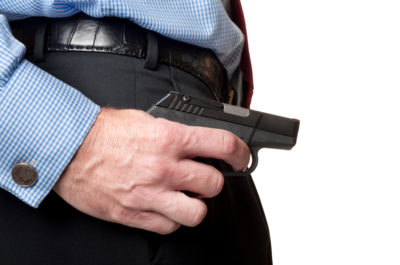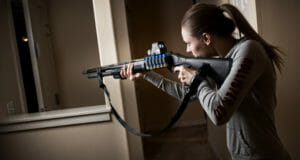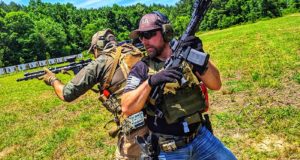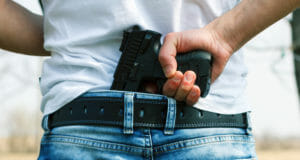When first learning to shoot a handgun, several concepts are introduced to the shooter, the most important of which are sight picture and sight alignment. While breath control and trigger squeeze are also instrumental in firing off an accurate shot, not mastering sight picture and sight alignment will result in shots that are constantly off target.
Sight picture and sight alignment are closely related, but not the same; sight picture is the accurate placement of the sights upon the target. You’re teaching your eyes to focus on the front sight, which should be in sharp focus, with the rear sight slightly blurred, and the target itself slightly blurred.
Sight picture is a concession to the way our eyesight works; humans cannot sharply focus objects that are varying distances from the eye. They can only sharply focus on one distance at a time. Sight alignment is the process of placing the front sight on target, while ensuring that the front sight appears perfectly aligned on a horizontal plane within the rear sight slot. All in all, it takes practice to develop instant, instinctive sight picture and sight alignment that results in accurate hits every time.
If you’re an avid pistol shooter, you’ll find that you spend the bulk of your time practicing the fundamentals of marksmanship as stated above, but there’s another area of handgun shooting you should practice as well: shooting your handgun without using the sights. While this might seem like anathema to a trained handgun shooter, it has its origins in the law enforcement realm and is taught by police academies everywhere, and for good reason.
First of all, before we explain how to shoot without using your sights, let’s look at how you shoot with your sights, from a holster draw. Using a firm master grip, you draw your weapon from its holster while at the same time breaking into your favorite Weaver or isosceles stance. You bring the pistol up so that the sights are more or less at the same level horizontally as your eyes. You look through the sights over the slide or barrel of your pistol, and fire off a shot. That’s the way it’s supposed to go, anyway, but guess what—law enforcement, through decades of confrontation, determined that it doesn’t always go this way, and thus two forms of sightless pistol shooting emerged.
Keep Your Handgun Locked and Loaded, Ready For Instant Use – Without Fear Of An Accident!
Borne from the fact that there were situations in which an officer encountered an imminent threat to his life, a threat so prescient and so rapid that he could not even raise the pistol to the level of his eyes, two methods were developed: point shoulder shooting, and hip shooting. Although varying police academies use different terms for these forms of sightless shooting, they cover more or less the same types of shooting. We’ll look at them both.
POINT SHOULDER SHOOTING
Point shoulder shooting was developed because situations emerged where the officer had to shoot his weapon to neutralize a threat so fast that he did not even have time to bring the sights up to his eye level. Laymen might wonder what could ever prompt an officer to be in such a hurry, and what time might be saved by not bringing the sights up to his eye level, but trust us, in police work, sometimes a deadly threat presents itself so fast that you must shoot—or die.
Point shoulder shooting is simple, intuitive, and easy to teach yourself. It uses instinct rather than dependence on your sights. It’s based on a curious human characteristic that manifests itself as hand-eye coordination. To try it, simply look at an object a few feet away. Now point your index finger at that object. Do you notice how your index finger always points at what your eye is focusing on? Without any training or practice, your index finger naturally finds the spot where your eye focuses on, and that’s what point shoulder shooting uses to aim. When you draw your weapon with your master grip, note that your index finger is usually pointing forward—it is not on the trigger, it is indexed along the trigger guard, and guess what?
It’s already pointing at what you’re looking at in most cases.
Point shoulder shooting is named that because you don’t bring the handgun up to your eyes, you only bring it up to shoulder height, and “point” using your finger at the target. Try it sometime at the range. You’ll find it’s very intuitive and, while you will not achieve the kind of accuracy you would get by using the sights, you will be able to hit the center mass of a target ten yards or so away reliably and without using the sights. It’s really a handy skill to learn as a backup, because there may be a time when you can’t raise that pistol fast enough.
HIP SHOOTING
Hip shooting is an even more desperate form of shooting for the direst circumstances. It was developed for officers to use in the most extreme circumstances when they didn’t even have time to use point shoulder shooting, and consists of drawing the weapon from its holster vertically and immediately rotating it 90 degrees to horizontal and firing. Basically, it resembles a gunslinger style pose; weapon comes up, rotates to horizontal, and fires, right there by your flank.
Hip shooting is designed to be used inside of three yards, in situations where the suspect is so close that you can’t draw your weapon to full height. There’s a really safe way to practice this as well. First, place your non-firing hand on your belt buckle and keep it there. This prevents you flagging your own hand. Next, with a firm master grip, draw your weapon up from its holster, and rotate it to horizontal. Do not place your finger on the trigger until it’s time to shoot. Instead, keep your trigger finger indexed. Look at the center of the target and your index finger will naturally gravitate to the target as well. Fire a group of three shots, guiding the bullets into the center of the target with each shot.
Point shoulder shooting and hip shooting should never replace using the sights, but they are a great alternate method of shooting to try and might just save your life one day.
 Off The Grid News Better Ideas For Off The Grid Living
Off The Grid News Better Ideas For Off The Grid Living





